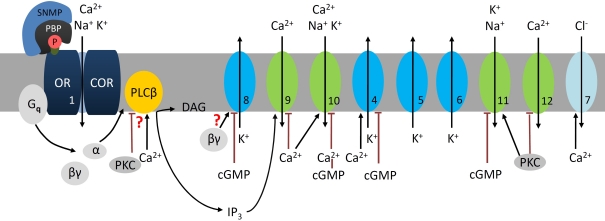Figure 3.
At night sensitive pheromone detection involves phospholipase Cβ (PLCβ) cascades in the hawkmoth M. sexta. During the moth's activity phase low, brief pheromone stimuli elicit phasic, sensitive odor responses. Pheromone–pheromone binding protein (P-PBP) binds to the pheromone receptor complex (OR–COR, 1) which activates a Gq-protein. The Gq(α) subunit activates a Ca2+-dependent PLCβ which hydrolyses phospholipids (PIP2) to IP3 and DAG. The Gq(βγ) subunit opens a delayed rectifier-type K+ channel (8, ∼30 pS), which is blocked by high levels of cGMP (Stengl et al., 1992). Depending on channel density it hyperpolarizes the ORN and decreases its spontaneous activity. Steep IP3 rises open a transient Ca2+ channel (9, <20 pS) in the outer dendrite. The resulting influx of Ca2+ triggers activation of nearby Ca2+-gated cation channels (10, ∼53 pS) before closing both channels (9, 10) via negative feedback causing desensitization (Stengl et al., 1992; Stengl, 1993, 1994). The resulting high amplitude, rapidly rising Ca2+-oscillations (depending on feedforward activation of PLCβ via Ca2+) and the depolarizations activate additional voltage- or Ca2+-gated channels: Ca2+-dependent K+-channels (4, ∼66 pS) and Cl− channels (7), voltage-dependent fast, transient IA-type (5, ∼30 pS), and delayed rectifier K+-channels (6, ∼30 pS), as well as Ca2+-channels (12) (Zufall et al., 1991a). Resulting hyperpolarizations together with Ca2+-dependent negative feedback, directly or indirectly via protein kinase C (PKC) terminate this pheromone-transduction cascade. Stronger, second-long Ca2+ rises via adapting pheromone stimuli activate PKC. The PKC-dependent down-regulation of PLCβ (Schleicher et al., 1994), closure of voltage-sensitive Ca2+ channels (12), and the gating of different cation channels which are not Ca2+ permeable (11, ∼40 pS, ∼60 pS not shown) causes slower, decreased depolarizations and decreased intracellular Ca2+ levels resembling conditions of short-term adaptation (Stengl, 1993; Dolzer et al., 2003, 2008). Because dropping intracellular Ca2+ levels will not activate the large, fast Ca2+-dependent K+ or Cl− channels, repolarizations will be slowed down, decreasing pheromone response kinetics. The PKC-dependently activated ion channels are closed via rises of cGMP-levels as occur under conditions of long-term adaptation (Figure 3). The numbers indicate the same ion channels in all Figures.

